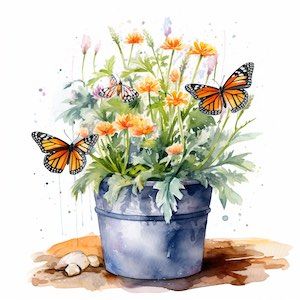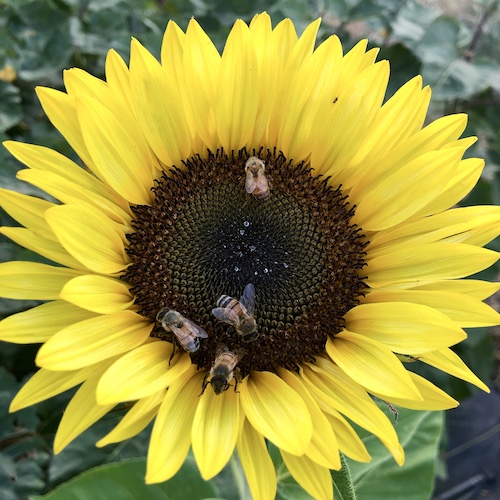How to Attract Pollinators: Welcoming Butterflies and Bees to Your Garden
Tips to attract pollinators
Creating a garden that’s not just a feast for the eyes but a haven for nature’s vital helpers is both rewarding and essential. In a world where the survival of pollinators is increasingly under threat, turning your garden into a sanctuary for these indispensable creatures is more important than ever. Whether you’re an experienced gardener or a green-fingered novice, this guide is designed to help you transform your outdoor space into a thriving ecosystem buzzing with life. From butterflies to bees, these tips will help you attract and sustain these vital pollinators, ensuring your garden not only blooms in vibrant splendor but also contributes to the health of our planet.
- Embrace Local Flora Delve into the world of native plants, which are the cornerstone of a pollinator-friendly garden. Native species like Milkweed and Purple Coneflower for butterflies, and Goldenrod and Lupines for bees, are not only easier to grow due to their adaptation to local conditions but are irresistible to native pollinators. Discover the indigenous flora of your region by consulting with local gardening clubs or botanical gardens. The addition of native grasses and perennials can also enrich your garden’s appeal to a diverse array of pollinators.
- Cultivate a Tapestry of Plants Think of your garden as a buffet for pollinators, offering a variety of dishes through the seasons. Integrate plants that bloom at different times, creating an unbroken chain of flowering from early spring to late autumn. This continuous bloom ensures that your garden remains a constant source of nourishment for various pollinator species. Grouping similar flowers can enhance the visibility and accessibility of these vital resources.
- Adopt Natural Pest Solutions Shift away from chemical pesticides to safeguard your winged visitors. Explore organic and natural pest control methods, such as encouraging the presence of beneficial insects like ladybugs. Creating a balanced ecosystem in your garden helps keep pest populations in check naturally, reducing the need for interventions and creating a safer space for pollinators.
- Create Havens for Rest and Reproduction Pollinators need more than just food; they require safe havens for rest, shelter, and reproduction. Incorporate features like tall grasses and dense shrubs for butterflies, and consider leaving natural debris like logs and branches, which can serve as nesting sites. For bees, a mix of bare soil and bee houses can provide vital nesting opportunities. Remember, a less manicured garden often makes a more inviting home for these creatures.
- Ensure Sustenance and Hydration Provisioning for the dietary needs of butterflies and bees is crucial. Butterflies are drawn to overripe fruits, so consider setting up a dedicated feeder. Additionally, a ‘butterfly puddle’ offers them essential minerals. Bees, on the other hand, need water sources that are safe and accessible. A shallow bird bath with stones for landing spots can serve as an excellent water station. Ensure your garden is also abundant in nectar and pollen-rich flowers to cater to their nutritional needs.
- Select Flowers with Care Both butterflies and bees have preferences in terms of color and flower structure. Butterflies are usually attracted to bright, warm-colored flowers with flat tops or short tubes, while bees favor flowers in hues of blue, purple, and yellow, which are easier for them to detect. Varying flower shapes and sizes in your garden caters to different species, with some favoring shallow blossoms and others adapted to probe deeper flowers.
- Beyond Flowers: Trees and Shrubs Matter Too Your garden’s appeal can be greatly enhanced by including a variety of trees and shrubs. Plants like Willow, Cherry, and Blackberry offer more than just flowers; they provide a rich source of nectar and pollen. The addition of these larger plants not only extends the flowering season but also adds structural diversity to your garden, offering additional shelter and foraging opportunities for pollinators.
- Foster a Safe and Welcoming Environment Gardening with pollinators in mind means being mindful of their safety. Regularly inspect and eliminate potential hazards, and be cautious with garden maintenance to avoid disturbing their habitats. Ensuring adequate water availability, especially during dry spells, is also crucial for creating a hospitable environment for these vital creatures.
Conclusion Embracing these practices transforms your garden into a thriving hub for pollinators, contributing significantly to the local ecosystem and global biodiversity. A pollinator-friendly garden is a dynamic, living space that not only brings joy and beauty but also plays a pivotal role in sustaining the natural world. By adopting these tips, you are embarking on a fulfilling journey to create a harmonious and sustainable garden that resonates with the rhythms of nature.












You must be logged in to post a comment.